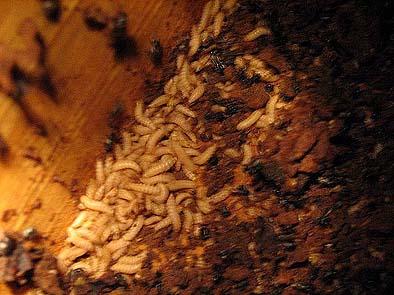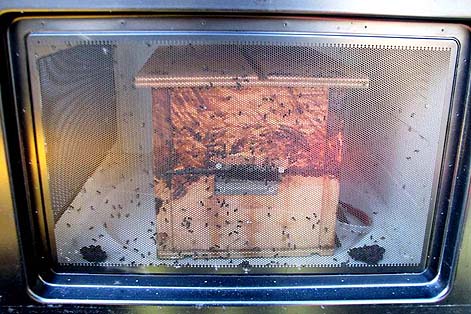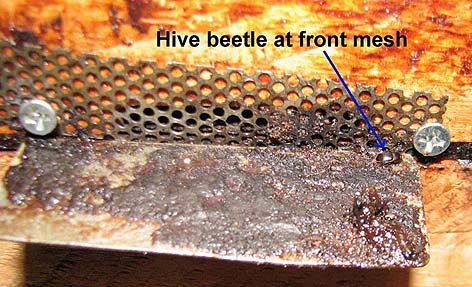Home
Aussie Bee Online
Welcome
New Articles
About Native Bees
Bee Photo Gallery
Bees in Your Area
Common Questions
Rescuing Native Bees
Exotic Bumblebees
What are Stingless Bees?
Buying Stingless Bees
Honey Production
Crop Pollination
Study Native Bees
Field Guide
Information Booklets
Tim Heard's Book
John Klumpp's Book
Aussie Bee Back Issues
Seminars
Links
Support Native Bees
Aussie Bee Shop
Order Form
Who We Are
Donations
Privacy Policy
Free Newsletter
Website Survey
Download Printer-Friendly PDF version of this article
with numerous extra photos
Keeping Out Small Hive Beetles
by Ric WadeMurwillumbah
January 2012
Ric Wade fought to save a nest of stingless bees (Trigona carbonaria) which he had recently transferred to a box. The bees had suffered a massive attack from the South African Small Hive Beetle, a serious hive pest that was introduced into Australia in 2002. However, Ric managed to save his bees through some very dedicated hard work and by engineering a precise beetle-excluding mesh for his hive. Here is Ric Wade’s story:
A Hive Rescued from a Sprinkler Valve Casing
Recently a friend asked if I would like to remove a Trigona nest that was in an underground sprinkler valve casing at a local nursing home.
I made up a box for it and carefully moved the brood, pollen and honey pots into the box. I left it beside the open sprinkler housing for two days so the bees could clean up. Then I brought the new hive home.
A Small Hive Beetle Attack Causes a Huge Clean Up Job
Within ten days after transferring the nest to the new box, I was disgusted to find that it was completely infested with Small Hive Beetle larvae. There was nothing left of the brood comb that I had so carefully transferred across.
 |
|
A mass of Small Hive Beetle larvae in Ric’s stingless bee hive.
(Don’t miss our bonus video with graphic footage of this infestation!) |
Tom Carter in Rockhampton, Queensland, said he has had a similar experience. He boxed one hive and the next morning it had about 30 hive beetles in it.
I carefully removed every larva. As you scooped up a handful with your fingertips they felt very hot – high metabolic rate, I suppose.
Every second day I opened the box and completed a ritual clean out. There was a very large amount of bees in this hive so I thought it had a good chance of recovering if I could only stop the beetles reinfesting it. The beetles started swarming in around 4.30 pm and continued to arrive until well after dark. I killed 28 on the first night after the initial clean out.
To prevent re-infestation while I was sleeping, I sealed the front entrance with some very fine steel mesh (1.5 mm holes). I obtained this mesh from the front door of a scrapped microwave oven. I would remove this mesh the next morning to allow the bees out to forage.
Controlling the Beetles Using an Old Microwave Oven
All of this screwing and unscrewing mesh became a bit trying. So after an inspirational thought, I decided to put the whole box into an old microwave oven, from which I had removed the front plastic covering to expose the mesh. On the cavity side of the mesh (the inside) there was also a clear soft plastic film which needed to be removed to allow ventilation.By picking at its edges, I could get a grip on it and peel it off slowly. I cleaned off any residual adhesive with mineral turps.
 |
|
Ric’s hive safe and sound at night inside his modified microwave oven.
|
There were also a few ventilation sections (3.0 mm diameter holes) at the rear and top of the oven cavity that I covered with the fine mesh. You will notice on the left hand inside of the oven I have cut away the solid metal (with a 100 mm angle grinder) and pop riveted in another piece of door mesh. This was to provide extra ventilation but I now don’t think that is necessary.
I shut the door around 4.15 pm and opened it again the next morning. Any bees left outside just camped locally overnight.This worked well. The beetles congregated on the outside of the door mesh and were easy to squash.
Ric’s Custom-Made Beetle Excluder Mesh
I then started to think about what size mesh a bee could pass through and yet exclude a beetle. I measured some dead bees and beetles and decided to try 2.5 mm (0.0984”) diameter holes. I had some other mesh with 2.0 mm holes in it so I drilled out every second hole to 2.5 mm. (When I attempted to drill out every hole it would break through into the adjacent hole and I would end up with a 5.0 mm slot which would allow a beetle to easily get in.) I installed my excluder across the entrance and it seemed to work well. The bees seemed to get used to it. They could pass through with their tiny saddlebags full of resin or pollen.
 |
|
A Small Hive Beetle that is unable to get into the hive entrance because of the fitted mesh excluder.
|
Then one afternoon I caught and killed a tiny hive beetle that was only 2.4 mm (0.0944”) wide. A rethink of the hole sizes was required and I decided to try a 3/32 inch drill (2.38 mm or 0.0937”). A new piece of mesh was drilled out with the 3/32” drill and fitted to the hive. So far it has been very successful and the bees can still navigate it OK.
I have now made up another box with the front access meshed over. I will eventually transfer the hive to this new box.
So if anyone is going to move a hive from a log to a box, or intends ‘stressing’ a hive in any way I suggest that they either:
(a) protect the hive inside a modified microwave oven for about two months. The door should be closed each evening around 4.15 pm (the earliest I have seen the beetles come in on a sunny day is 4.20 pm, 4.00 pm on a cool overcast day) and opened again 7 am to 8 am the next morning. This would save the bees from certain destruction from the attacking beetles.
or
(b) fit a mesh excluder to the front entrance. Ideally this should remain in place until the bees have regained their social composure and resume guarding the hive entrance.
After about two months the mesh can be replaced with another piece of mesh with slightly larger chamfered 2.50 mm holes in it. As a safety precaution I am fitting a front access excluder to all of my hives and leaving it there permanently
Postscript
Since writing this story for Aussie Bee, Ric Wade has spotted two even smaller Hive Beetles that were only 2.26 - 2.28 mm wide. Unfortunately these beetles were tiny enough to crawl through the special 2.38 mm (3/32”) mesh screens that Ric made for his hive.
Ric said that most bees can traverse the 2.38 mm holes in his mesh easily, but those returning heavily loaded with pollen sometimes have difficulty getting though. They pull one leg through first then the other. So he was reluctant to reduce the hole sizes down further to exclude these micro beetles.
Ric added that the 2.38 mm mesh holes definitely exclude the larger black adult beetles and, combined with the microwave night shelter, it has ‘worked a treat’ so far for this previously brood comb decimated hive. However, as the smallest beetles can squeeze through the mesh, Ric warns that beekeepers should not just fit a mesh like this and become complacent.
The mesh that Ric makes has been ‘spun formed’ from both sides so the holes have a nice rounded edges. He says the foraging bees normally do not lose their collected balls of pollen on this type of mesh.
However, if mesh is made by simply drilling the holes, this leaves sharp edges. Unfortunately these sharp edges can strip off the bees’ pollen balls. The sharp edges can be removed by rotating a slightly larger drill bit by hand on both sides of each hole, just enough to chamfer the sharp edge off.
The worker bees also cannot push bees that have died inside the hive through the mesh holes. So it is necessary to occasionally remove the mesh for a few hours in the middle of a sunny day (when the beetles are hopefully asleep) so that the workers can clear their rubbish stockpile.
Aussie Bee congratulates Ric Wade on his dedicated, inventive and skilful work to keep these South African Small Hive Beetles out of his newly boxed hive. With pests like this it is a numbers game. If the pests are only present in small numbers, the bees can often cope. In fact, our stingless bees can kill these Small Hive Beetles by entombing them in resin (see Aussie Bee Online Article 12)! However, if large numbers of pests get into the hive, they can overwhelm a colony.
Ric’s custom-made mesh cannot exclude the very smallest Hive Beetles. However, it would help a vulnerable colony a great deal by keeping the majority of beetles out of the hive until the bees have time to repair their defenses.
|
Bonus Video!
Ric Wade sent Aussie Bee a series of video clips that really bring his story to life! See the devastation caused to the hive by these Small Hive Beetles and Ric’s special mesh excluder in action! Aussie Bee has combined these clips into a short video that you can view here: www.aussiebee.com.au/video-wade-1.html |
If you would like to contact Ric Wade to discuss his Small Hive Beetle protection systems, you can ring him on 02 6672 2189.
Download PDF version of this article
with numerous extra photos
(If you have not used PDF before, click here.)
Bonus Video about this article
• For more interesting Aussie Bee Online articles on native bees, visit the contents
.
|
Please feel free to print out this article or to email copies of the PDF version to your friends. This article may also be reproduced or hosted on other websites providing it is kept in its full and unaltered form including ANBRC contact details.
|
.
Search Aussie Bee Website:
© 1997-2018 Australian Native Bee Research Centre
PO Box 74, North Richmond NSW 2754, Australia